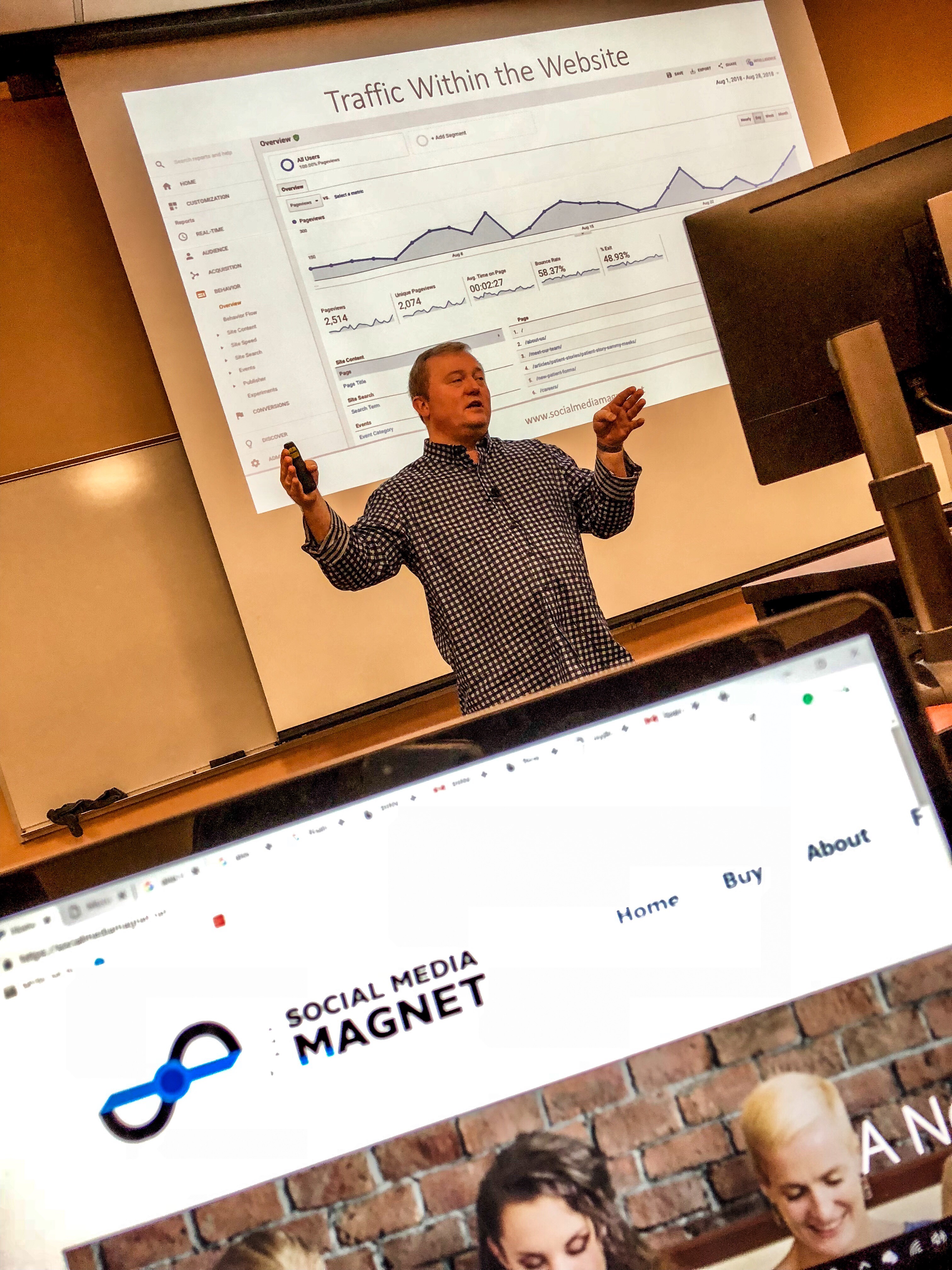
In 2013, due to personal family reasons, I left my current university where I was an assistant professor to start a new adventure at another university more than 10 hours away from where I resided. I was leaving a university that I had grown very fond of and leaving a beautiful place to live that had a much slower pace of life than where I was headed. I was switching from a public school to a private school, and I was now going to be required to teach new classes that I had not yet prepped. One of those was Social Media Marketing.
I started down the road that many professors travel when asked to teach a new class. I ordered a few textbooks from known publishers and I began skimming through the books looking for interesting chapters. One-by-one I started to notice that this was going to be more difficult than I had assumed. First, I didn’t know much about the topic having never worked in digital before, and two, I began to wonder if these textbooks were even still current under the assumption that digital marketing moves at blinding speed, at least, relative to the traditional marketing theory that I had been teaching for years.
Time was of the essence, so I chose one. It didn’t matter which one, just one. That semester was seriously a disaster. Regurgitating typologies and using stories that students knew were not my own was a real discouragement. At the time, I was only teaching this every Fall, not every semester, so I set out with a plan to improve my next experience. I also taught our capstone class, Strategic Marketing Management, and I used a simulation in that class. And while there were some new startups that offered a simulation, I was never satisfied that a simulation was the route I personally wanted to go as I demoed the products and answered all of their phone calls to my office.

In the first semester at my new university, I had made an all-call to the local Nashville American Marketing Association (NAMA) chapter and invited them to come sit in on some presentations my capstone students were delivering. A few of them showed up, and an immediate friendship was made with one of the volunteers, Elliott Cunningham, who was the CMO at a local company. He invited me to a local establishment for a drink and a cigar, and a seed was planted for the idea of how to replicate the simulation effect from my strategy class, but in a live environment so that students could interact with real content, real people, real analytics, real strategies, real tactics, etc. You get the idea. We didn’t want to create another simulation. The digital world is dynamic, and we wanted the students’ user experience to be dynamic too, even if that meant we couldn’t control the real live problems that a live campaign can bring.
From that day, Elliott and I started working on a new pedagogy for my class. We would create a practicum that provided this real experience. We went through several simple iterations at WordPress.com, using only the site analytics to try and help drive strategic principles, but it wasn’t dynamic enough. We could not use google analytics with it, a critical learning piece, and the plugin functionality was minimal at best. No, if we were going to truly teach a complete inbound, organic campaign process, it would require us to move to WordPress.org and completely open up the toolkit. At first, it took me hours of setup for my class, and while we achieved the dynamic iteration we wanted, the scalability was impossible. No other professor would take this much time to admin the class, grade all of the metrics by hand, and provide feedback on each campaign. We had to figure out a way, like a simulation, to perform these abilities with minimal impact on the professors if we ever wanted to possible bring this idea to market.
And then a breakthrough… we had found our way through the maze of scalability. Literally, we shouted for joy because we knew that students appreciated our pedagogy. Quantitative evaluations were stellar and qualitative feedback was equally positive and supportive. Students were landing great jobs based on their resume and portfolio pieces, and local companies started calling asking about the curriculum. The only thing left to do was put all of the resources together, but as we started to explain the process, another amazing thing happened.
We started to diagram how all of this works, and the models lead to an epiphany regarding theory. We realized that the messaging acted like a magnet, drawn to the messages communicated by the company or individual. Wherever the messages lead, there your brand will go also. We had been following it in the mass media with companies like DirecTV, McDonald’s, and a local company named Swiftwick. When we modeled the hub-and-spoke design onto our Brand Matrix, we started to see how acquisition and retention-based messages were pushing (and in some cases, pulling) brands into quadrants where their messaging was diluting their brand, and there were consequences to these strategies. (A link to our white paper on the theory will be provided below.)
We incorporated the theory into our digital textbook (it had to be digital because print text goes out of date in this arena in a short period of time), built assignments around the practicum process, and because we were in a digital environment, strategically added competency assessments to each of our content levels for student accountability. This is critically important because if students don’t keep up, then the practicum can become an absolute disaster for the student. We want them to learn, but at a pace that we dictate in order to help them grasp the compounding nature of the material. All of this builds to preparing students to launch an online digital campaign and audit their live results in order to make strategic and tactical decisions when necessary to continue to propel the campaign forward. The completed experience is one that students are still raving over, volunteering to put their story forward in our blogs because they are so proud of what they have built, like Emily’s below.
Since we started marketing The Social Media Magnet, I have heard from many professors that you have wanted, or even tried, to build this experience for your students in the previous few years. However, the immense amount of time that it required prevented you from other job responsibilities, primarily research. I truly believe our courseware will prove differently. We have built into the courseware all of the tactical processes for students to create and manage their practicums on their own. We have domain and web hosting instructions to assist the student in the purchase process. We have a complete WordPress website instruction set to help them learn how to install plugins, themes, form builders, and analytics platforms to monitor their process. We even have our own plugin that students are required to install to monitor their campaign, give them feedback on how to improve, and grade their campaigns. Yes, it grades the campaign and reports the grade back to you in your professor analytics dashboard. In your dashboard, you can monitor each student’s progress throughout the campaign and provide feedback as often as you wish. As one professor has acknowledged, “I used to have to carry my students across the threshold, but you have reduced this to barely a hand-hold. This is great!”
Our journey has provided us with an opportunity to help other professors teach Social Media Marketing in a way that allows students to learn in a real-time, live environment. With our curriculum, students get to choose their own topic and build assets they can choose to keep forever. Entrepreneurial-minded students can start promoting their business ideas (or eventually products or services). Music Business students can start to promote their songs or label. Communications students can start learning how the market reacts to broad or narrow cast messages. Marketing students learn the value of discovering target markets and how content is perceived by those users, preparing them for paid media campaigns as the next step in their content creation process. There are many different angles that a professor could take to make our curriculum fit their class objectives, so let’s discuss it.
How can you envision using the Social Media Magnet in your class?
If you are a college professor curious about The Social Media Magnet, check our professor overview with highlights of our features and benefits. If you would be interested in considering The Social Media Magnet for your university, we have a professor preview function that would allow you to see and work with some of the content. Within the professor preview, we have a complete list of instructor’s resources available when you adopt the course. If you are interested in our theory, then read our abstract and request our white paper. Or if you just have some general questions, feel free to contact us. We would love to assist you however possible.




beyond impressed with the course you’ve created for us! This is one of the most engaging classes I’ve taken. Very interesting to read about your progression.
Very excited to be able to learn first hand so many techniques. The assignments so far have taught me so many skills that I’m excited to apply to future internships and jobs.
Amber, developing skill sets was a top priority when we created The Social Media Magnet. I’m glad that you are recognizing its value. I’m sure your future employers will too.
Thanks Benton. It has been created with a lot of time and care. I appreciate you letting us know your thoughts. Keep up the good work this semester.